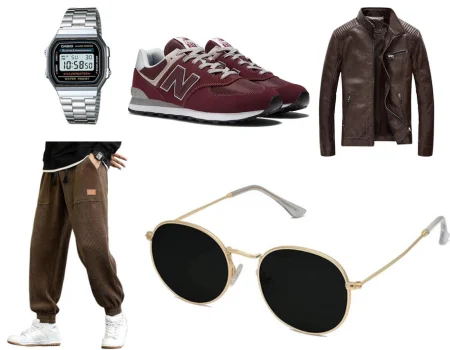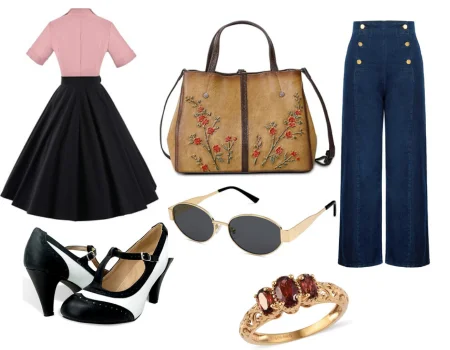If you’re into vintage fashion, for men or women, this store has all the clothes you can imagine: Nike hoodies, that 50s dress you’ve been searching for, antique watches, retro shirts and dresses, or that sexy cabaret-style corset that will leave anyone who sees you speechless. If you’re looking for retro clothes online to wear every day or simply a retro costume for Halloween…
Welcome to the best retro clothing store, welcome to Vintage Store.
To wear vintage clothes in a more personalized way
Shop by brand
If vintage clothing still catches the attention of so many people today, it’s thanks to the great brands that made unique garments that remain desired in our time. Many contributed to this current trend, but among the most notable are:
Nike
Zapaca
Retro clothing, a fashion for all times.
otros productos
What is vintage clothing?
Vintage clothing refers to garments and accessories that are between 20 and 100 years old, though some narrow this range to clothing between 25 and 75 years old. This type of clothing includes not only used items but also those that have been stored and never used, sometimes known as “new old stock” (NOS). Vintage clothing can be found from popular brands of the era as well as from famous designers.
Fashion history by decade (1920-1990)
1920s:
The 1920s, known as the “Roaring Twenties,” was a time of liberation in fashion. Women adopted more relaxed styles with straight, waistless dresses and shorter skirts, popularizing the flapper look. Men began to wear more fitted and less formal suits.
1930s:
In the 1930s, women’s fashion became more elegant and refined, with long, fitted dresses that emphasized the figure. The influence of Hollywood cinema was evident, with actresses like Greta Garbo and Marlene Dietrich setting trends. Men continued to wear suits, but with a broader, more relaxed style.
1940s
During World War II, fashion became more practical and functional due to material shortages. Women began to wear pants and workwear, while men’s suits were simplified. After the war, women’s fashion became more feminine and sophisticated, with the introduction of Christian Dior’s “New Look” in 1947.
1950s
The 1950s were marked by elegance and glamour. Women wore dresses with wide skirts and fitted waists, while men continued to wear well-tailored suits. Youth culture also began to influence fashion, with the popularization of jeans and t-shirts among teenagers.
1960s: The 1960s were a time of revolution in fashion, with the introduction of bolder and more colorful styles. Miniskirts, trapezoid dresses, and psychedelic prints became trendy. Men’s fashion also became more experimental, with fitted suits and brightly colored shirts.
1970s
The fashion of the 1970s was characterized by its diversity and the influence of hippie culture. Clothing from this decade included bell-bottom pants, bohemian blouses, and disco-style outfits with shiny, fitted fabrics. Men also adopted more relaxed and colorful styles.
1980s: The fashion of the 1980s was extravagant and ostentatious, with the popularization of neon colors, shoulder pads, and flashy accessories. Both men and women adopted bolder and unconventional styles, influenced by the music and pop culture of the time.
1990s
The 1990s saw a mix of grunge, minimalist, and sporty styles. Fashion became more casual, with the popularization of ripped jeans, band t-shirts, and sportswear. Both men and women embraced a more relaxed and comfortable fashion.
Differences between vintage and retro clothing
The main difference between vintage and retro clothing lies in their origin and authenticity. Vintage clothing is authentic, made in the era it represents, while retro clothing is modern and simply imitates or is inspired by past styles. Vintage clothing tends to have historical and collectible value, while retro clothing focuses more on aesthetics and design.
Top vintage clothing brands
Chanel: Founded in 1910 by Coco Chanel, this French brand is synonymous with elegance and sophistication. Its vintage pieces, such as tweed suits and cocktail dresses, are highly valued by collectors.
Dior: Christian Dior revolutionized fashion in 1947 with his “New Look.” His vintage dresses are famous for their full skirts and narrow waists and remain highly sought after.
Yves Saint Laurent: Since its founding in 1961, Yves Saint Laurent has been known for its innovative and elegant style. Its vintage pieces include iconic tuxedo jackets and evening gowns.
Givenchy: Founded in 1952, Givenchy is known for its elegant and sophisticated designs. The brand’s vintage dresses are famous for their clean cuts and elegant lines.
Reasons for the demand for vintage clothing
The popularity of vintage clothing is due to several factors:
Sustainability: Reusing old garments reduces the environmental impact associated with producing new clothes.
Quality: Many vintage garments were made with high-quality materials and superior tailoring techniques compared to today.
Unique style: Vintage clothing offers unique styles that can’t be found in modern stores, allowing individuals to stand out.
History and nostalgia: Vintage garments carry history and a sense of nostalgia that resonates with many buyers.
Vintage clothing offers a window into the past, allowing fashion lovers to experience authentic styles from previous decades. Its demand continues to grow thanks to the search for originality, sustainability, and quality as more people become interested in sustainable fashion and conscious consumption.


